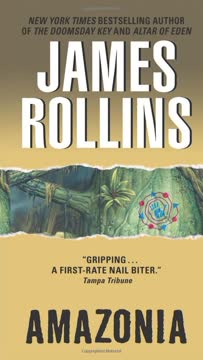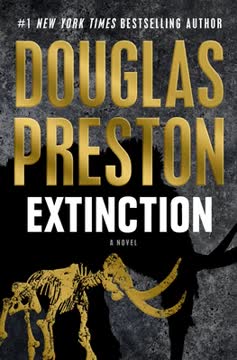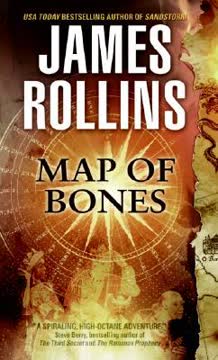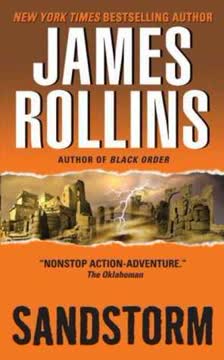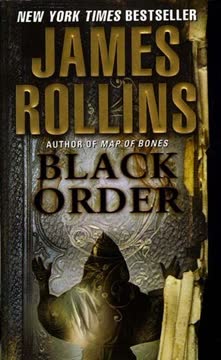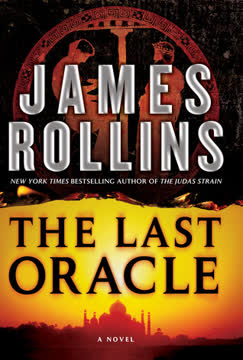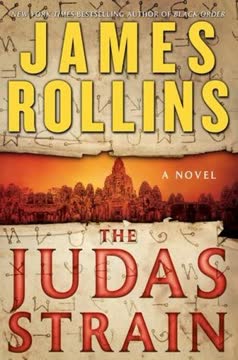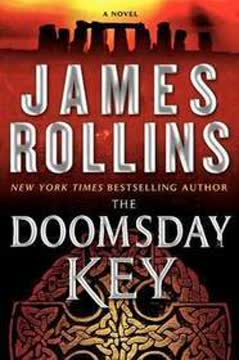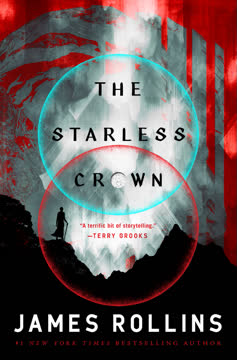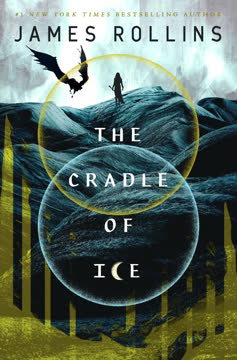Plot Summary
Jungle's Dark Messenger
A fevered, mutilated man stumbles out of the Amazon and dies in a remote mission, but not before revealing a shocking secret: he is Gerald Clark, a Special Forces operative missing for four years. Even more astonishing, Clark, who lost an arm years ago, now has both arms. His body is covered in strange tattoos, and his death is surrounded by superstition and fear among the local tribes. The event triggers alarm in the U.S. intelligence community, as Clark's return is medically impossible and his body is riddled with aggressive cancers. The mystery of his reappearance, and the supernatural implications, set the stage for a high-stakes investigation into the heart of the Amazon.
The Lost Expedition
Four years earlier, a scientific expedition led by Dr. Carl Rand vanished without a trace in the Amazon. The team, which included researchers, guides, and covert operatives, was presumed dead after a desperate final radio message. The disappearance becomes a cold case until Clark's miraculous return. The U.S. government, pharmaceutical interests, and the CIA are all drawn back into the mystery, suspecting that the lost team may have discovered something extraordinary—something worth killing for, and something that could change the world.
Gathering the Team
Nathan Rand, Carl's son and a botanist, is recruited to join a new expedition to retrace Clark's path and uncover the fate of the original team. He is joined by a mix of scientists, soldiers, and indigenous experts: Dr. Kelly O'Brien, a medical doctor; her brother Frank, a CIA operative; Professor Kouwe, a shaman and anthropologist; Manny, a biologist with a pet jaguar; and a squad of Army Rangers. Corporate and intelligence interests, including the shadowy Tellux Pharmaceuticals and the CIA's environmental division, back the mission. Unknown to them, mercenaries and rival interests are also mobilizing, intent on intercepting whatever secret lies hidden in the jungle.
Into the Green Abyss
The team plunges into the Amazon, following the faint trail left by Clark. They encounter the jungle's relentless dangers: venomous creatures, disease, and the ever-present threat of hostile tribes. Early on, they save a Yanomamo girl from an anaconda, earning the tribe's trust. The group's cohesion is tested by cultural clashes, environmental debates, and the psychological toll of the jungle. As they travel by boat and on foot, they find evidence of Clark's passage and signs of the lost expedition, but also hints of something unnatural—mutations, strange animal behavior, and the recurring symbol of the Blood Jaguar, a legendary ghost tribe.
Curses and Cures
The team's medical expertise is put to the test when a child suffers a mysterious seizure. Western medicine fails, but Professor Kouwe's shamanic remedies succeed, highlighting the value of indigenous knowledge. Meanwhile, autopsies on Clark's body in the U.S. reveal a biological impossibility: his regenerated arm appears to have grown from a cancerous mass, and his body is riddled with rapidly developing tumors. Scientists theorize that a unique agent—possibly a prion or mutagenic protein—may be responsible, capable of both miraculous healing and deadly disease. The search for a cure becomes urgent as a new, deadly epidemic begins to spread from Clark's corpse.
Predators Unleashed
As the team ventures deeper, they are stalked by unseen trackers and encounter increasingly bizarre and lethal wildlife: piranha-frog hybrids, swarms of carnivorous locusts, and giant black caimans. These creatures seem to be controlled or summoned, targeting the outsiders with unnatural precision. The team suffers casualties, including several Rangers, and is forced to adapt, using both modern weapons and shamanic knowledge to survive. The attacks are linked to the Blood Jaguar tribe, who wield the jungle itself as a weapon, and to a mysterious, ancient tree at the heart of the forest.
The Blood Jaguar's Mark
The Blood Jaguar symbol—a red serpent and blue handprint—appears repeatedly, marking villages and sites of disaster. The team learns that the Ban-ali, or Blood Jaguars, are a secretive tribe with the power to manipulate the jungle's biology. Their territory is protected by genetically altered animals and plants, and their society is built around a sacred tree, the Yagga, which grants miraculous healing but also enforces a deadly curse on those who try to leave. The team realizes that the lost expedition may have become prisoners—or worse, subjects—of the Ban-ali's experiments.
Death in the Night
The expedition is ambushed by both mutant creatures and human enemies. A traitor in their midst, Richard Zane, sabotages their communications and aids a mercenary force led by the sadistic Louis Favre and his witch-like Shuar companion, Tshui. The Ban-ali village is attacked, its people slaughtered, and the sacred tree targeted for destruction. Key members of the team are killed or captured, and the survivors are left bound and helpless as Favre prepares to destroy all evidence of the Yagga and escape with samples of its sap.
The Tree of Miracles
Nathan, Kelly, and Kouwe discover the true nature of the Yagga tree. Its sap contains a unique prion that can trigger regeneration and rapid healing, but also causes fatal disease if its "antidote"—the tree's nut milk—is not regularly consumed. The Ban-ali are revealed to be both beneficiaries and slaves of the tree, genetically altered over generations. The tree's root system is a living genetic library, storing animals and even humans in suspended animation to harvest their DNA. Nathan finds his father, Carl Rand, alive but barely sustained by the tree's roots, and rescues him.
Betrayal and Fire
Favre's mercenaries capture the survivors, loot the Yagga's sap, and rig the valley with explosives. He plans to destroy the tree, erase all evidence, and sell the secret to the highest bidder. Kelly and Frank are taken as hostages, while the rest are left to die in the coming inferno. The Ban-ali are nearly exterminated, and the valley's unique ecosystem faces annihilation. In a final act of cruelty, Favre murders Manny, Nathan's friend, and prepares to torture Kelly to force Frank's cooperation.
The Root's Secret
Nathan, aided by the Ban-ali scout Dakii and the remaining survivors, discovers a hidden passage through the Yagga's root system. In a hallucinogenic ritual, Nathan learns the cure for the spreading plague: the nut milk of the Yagga, which suppresses the deadly prion. The group rescues Carl Rand from the tree's genetic vault and gathers as many nuts as possible. With time running out, they lead the surviving Ban-ali through the underground tunnels, escaping just as the valley erupts in fire and the Yagga is destroyed.
The Last Stand
Favre's group, believing the others dead, flees through the jungle with Kelly and Frank. Nathan and the survivors, aided by the Ban-ali and their jaguar allies, launch a surprise attack on the mercenary camp. In a brutal confrontation, Favre is killed by the jaguars, and Kelly is gravely wounded but saved. The cure is secured, and the remaining mercenaries are defeated. The survivors are rescued by helicopter as the jungle burns behind them, and the secret of the Yagga is lost—except for the precious samples they carry.
Escape and Ashes
The Yagga and the Ban-ali valley are reduced to ashes, erasing the evidence of the tree's power and the horrors it spawned. The survivors mourn their dead but return to civilization with the cure for the plague. The Ban-ali, now refugees, are resettled with the help of Carl Rand and Professor Kouwe. The world is saved from the epidemic, but the cost is high, and the mysteries of the jungle remain only partially understood.
Healing and Homecoming
Months later, the survivors rebuild their lives. Frank, whose legs were lost to a jaguar, regrows them through the Yagga's regenerative process, becoming a medical marvel. Kelly and Nathan, now engaged and expecting a child, find hope and healing in each other. The Ban-ali are compensated for their losses, and the world benefits from the cure, though the true nature of the Yagga remains a scientific enigma. In the jungle, life goes on, and a new seed is planted, hinting that the cycle may one day begin again.
Characters
Nathan Rand
Nathan is the ethnobotanist son of the vanished Dr. Carl Rand, driven by guilt, loss, and a need for closure. Scarred by his parents' deaths and his own failures, he is both skeptical and open to the jungle's mysteries. Nathan's journey is one of transformation: from a man running from pain to a leader who embraces both science and shamanic wisdom. His relationships—with Kelly, his friends, and the Ban-ali—force him to reconcile modern rationality with ancient belief, and his ultimate act of rescuing his father and discovering the cure is both personal redemption and a gift to the world.
Dr. Kelly O'Brien
Kelly is a brilliant, compassionate doctor, torn between her scientific training and the realities of the Amazon. Her fierce love for her daughter and brother drives her, and she is forced to confront her own vulnerability and strength. Kelly's arc is one of integration: she learns to value indigenous knowledge, faces trauma and loss, and ultimately finds hope and new life with Nathan. Her medical expertise is crucial to the team's survival, and her personal journey mirrors the book's theme of healing through both science and spirit.
Professor Resh Kouwe
Kouwe is a former tribal shaman and Oxford-trained anthropologist, uniquely positioned between worlds. He is the team's moral compass and cultural interpreter, advocating for respect of indigenous wisdom and warning against the hubris of Western science. Kouwe's deep empathy and knowledge save lives, but he is also haunted by the violence and exploitation he has witnessed. His role is to guide others through the jungle's mysteries, and his ultimate act—helping Nathan become a shaman and discover the cure—cements his legacy as a bridge between worlds.
Dr. Carl Rand
Carl is the legendary leader of the lost expedition, a man whose ambition and curiosity lead to both discovery and disaster. His years as a captive of the Ban-ali and the Yagga's root system leave him physically and emotionally broken, but his scientific records and paternal love are key to the team's success. Carl's fate—rescued but forever changed—serves as a warning about the costs of unchecked exploration and the limits of human control over nature.
Dr. Richard Zane
Zane is the Tellux Pharmaceuticals representative, motivated by profit and self-preservation. His betrayal of the team and alliance with Favre's mercenaries make him the human face of corporate exploitation. Zane's actions catalyze much of the book's tragedy, and his ultimate fate—devoured by the jungle's own creations—serves as poetic justice and a critique of those who would commodify nature's miracles.
Louis Favre
Favre is a ruthless, charismatic French mercenary, driven by revenge, greed, and a twisted sense of artistry. His partnership with the witch Tshui and his orchestration of the village's destruction make him the book's primary antagonist. Favre's psychological complexity—his enjoyment of cruelty, his respect for worthy adversaries, and his ultimate downfall—reflects the dangers of unchecked ambition and the darkness that can arise when humanity is divorced from empathy.
Tshui
Tshui is Favre's Shuar lover, a headhunter and practitioner of dark arts. She is both feared and respected, embodying the jungle's capacity for both healing and horror. Tshui's presence amplifies the book's themes of the supernatural and the limits of Western understanding. Her artistry in torture and her ultimate death at the hands of Kouwe symbolize the clash between indigenous power and outside exploitation.
Frank O'Brien
Frank is Kelly's brother, a CIA operative whose injuries and subsequent regeneration make him a living testament to the Yagga's power. His journey from protector to patient, and his struggle with vulnerability, mirror the book's exploration of the costs and possibilities of transformation. Frank's survival and healing offer hope, but also raise questions about the ethics and consequences of such miracles.
Manny Azevedo
Manny is a Brazilian biologist and Nathan's close friend, notable for his deep connection to the jungle and his pet jaguar, Tor-tor. Manny's humor and expertise ground the team, but his death at Favre's hands is a turning point, fueling Nathan's quest for justice. Manny's relationship with Tor-tor and his respect for the jungle's mysteries highlight the book's theme of interdependence between humans and nature.
Tor-tor
Tor-tor is more than a pet; he is a symbol of the jungle's power, loyalty, and unpredictability. His actions—saving team members, forming bonds with wild jaguars, and avenging Manny's death—underscore the blurred lines between domestication and wildness. Tor-tor's presence is a reminder that survival in the Amazon depends on respect, adaptation, and sometimes, the help of unexpected allies.
Plot Devices
Duality of Science and Shamanism
The narrative structure juxtaposes Western scientific rationality with indigenous shamanic wisdom, using alternating perspectives and crises that require both approaches. The team's survival depends on integrating these worldviews, and the ultimate solution—the cure—emerges from their synthesis. Foreshadowing is used through early medical failures and shamanic successes, preparing the reader for the revelation that neither tradition alone is sufficient.
Biological Horror and Evolutionary Mystery
The book employs escalating encounters with mutant creatures and inexplicable phenomena to build suspense and horror. The Yagga tree is both a source of healing and a vector of disease, embodying the double-edged sword of evolution. The plot uses the motif of the "curse" to explore the unintended consequences of tampering with nature, and the prion's duality as healer and killer is mirrored in the jungle's beauty and brutality.
Betrayal and Human Greed
The presence of a traitor within the team, the machinations of corporate and mercenary interests, and the ultimate destruction of the Ban-ali valley all serve as plot devices to critique human greed and the commodification of nature. The narrative uses misdirection and shifting alliances to keep the reader uncertain about whom to trust, and the betrayals catalyze the story's darkest moments.
The Hero's Descent and Transformation
Nathan's journey follows a classic hero's arc, but with a psychological twist: his descent into the Yagga's root system is both literal and symbolic, representing a confrontation with death, grief, and the unknown. The hallucinogenic ritual and the rescue of his father serve as rites of passage, transforming Nathan from a passive seeker to an active shaman and healer. The structure uses dreams, visions, and ancestral memory as devices to reveal hidden truths.
Time Pressure and Ticking Bombs
The narrative is structured around multiple ticking clocks: the spread of the plague, the approach of the wet season, the detonation of explosives, and the race to find a cure. These devices create relentless momentum, forcing characters to make impossible choices and sacrifices. The use of alternating scenes between the jungle and the outside world reinforces the global stakes and the interconnectedness of all actions.
Analysis
Amazonia is a high-octane fusion of adventure, science fiction, and ecological thriller, using the Amazon as both setting and metaphor for the unknown depths of nature and the human psyche. The novel interrogates the limits of Western science, the value of indigenous knowledge, and the dangers of unchecked ambition—whether corporate, military, or personal. Its central motif, the Yagga tree, embodies the paradox of nature: a source of healing and transformation, but also of enslavement and destruction. The book warns against the hubris of trying to control or commodify the natural world, suggesting that true survival and progress depend on humility, respect, and the willingness to learn from what we do not understand. Ultimately, Amazonia is a story about the costs of discovery, the necessity of integration between old and new, and the enduring power of hope and renewal—even in the face of loss and devastation.
Last updated:
FAQ
Synopsis & Basic Details
What is Amazonia about?
- High-stakes jungle expedition: Amazonia plunges readers into a thrilling quest deep within the Amazon rainforest, where an ethnobotanist, Nathan Rand, joins a covert U.S. government and corporate expedition to uncover the fate of his father's lost research team. Their mission is triggered by the miraculous, yet horrifying, reappearance of a Special Forces operative, Gerald Clark, who vanished four years prior and now possesses a regenerated limb and a body riddled with aggressive cancers.
- Unraveling a biological mystery: The narrative follows the team as they retrace Clark's impossible journey, confronting mutated creatures, ancient indigenous tribes, and a spreading, deadly contagion linked to Clark's body. They seek to understand the source of both miraculous healing and devastating disease, which appears to stem from a legendary "ghost tribe" and a mysterious, ancient tree.
- Race against time and betrayal: As a global pandemic looms, the expedition faces relentless natural dangers and human adversaries, including ruthless mercenaries and a traitor within their ranks. The story becomes a desperate race to secure a potential cure hidden within the jungle's heart, battling not only the Amazon's primal forces but also the greed and ambition of those who seek to exploit its secrets.
Why should I read Amazonia?
- Pulse-pounding scientific thriller: James Rollins masterfully blends cutting-edge science (prions, stem cell research, genetic mutation) with relentless action and adventure, creating a narrative that is both intellectually stimulating and viscerally exciting. The novel offers a unique take on biological horror and evolutionary mystery, keeping readers on the edge of their seats.
- Deep dive into Amazonian lore: Beyond the action, Amazonia provides a rich, immersive experience of the Amazon rainforest, exploring its ecological wonders, indigenous cultures, and ancient myths. Rollins integrates ethnobotanical knowledge and shamanic wisdom, offering a respectful yet thrilling portrayal of a world where nature holds profound, often terrifying, secrets.
- Compelling character journeys: The story features a diverse cast of characters, each grappling with personal demons, moral dilemmas, and the overwhelming power of the jungle. Nathan Rand's quest for closure, Kelly O'Brien's struggle between science and faith, and Professor Kouwe's role as a cultural bridge provide emotional depth that elevates the novel beyond a simple action-adventure.
What is the background of Amazonia?
- Environmental and geopolitical context: The novel is set against a backdrop of real-world concerns regarding Amazonian deforestation, drug trafficking, and the exploitation of indigenous lands and knowledge. The CIA's Environmental Center and the Brazilian Indian Foundation (FUNAI) are key players, highlighting the complex interplay of environmental protection, national security, and corporate interests in the region.
- Scientific speculation on prions: A core element of the Amazonia background is the scientific concept of prions—proteinaceous infectious particles—which, at the time of the book's publication (2002), were a relatively new and intriguing area of biological research, particularly in their role in diseases like mad cow disease. Rollins extrapolates this science to imagine prions capable of both regeneration and rapid, deadly contagion.
- Cultural clash and indigenous wisdom: The story draws heavily on the rich cultural tapestry of Amazonian tribes, particularly the Yanomamo and the fictional Ban-ali. It explores the tension between Western scientific methods and indigenous shamanic practices, emphasizing the profound, often overlooked, wisdom held by native peoples regarding their environment and its hidden properties.
What are the most memorable quotes in Amazonia?
- "In their jungle, the Indian know everything.": This proverb, repeated by Nathan Rand and Professor Kouwe ("Na boesi, ingi sabe ala sani"), encapsulates a central theme of Amazonia: the profound, often underestimated, wisdom of indigenous peoples regarding their environment. It serves as a constant reminder that Western scientific arrogance can be a fatal flaw in the face of the Amazon's ancient mysteries.
- "Welcome to the jungle.": Nathan Rand's sardonic remark to Frank and Kelly O'Brien after detailing the horrors of assassin bugs, river blindness, and the candiru fish, perfectly captures the novel's blend of scientific detail and dark humor. It highlights the Amazon's relentless dangers and the stark reality that survival often means accepting the brutal terms of nature.
- "Where there is life, there is hope.": Professor Kouwe's whispered words to a despairing Nathan Rand, bound and awaiting death, offer a poignant counterpoint to the pervasive horror and betrayal. This quote, delivered in a moment of utter hopelessness, underscores the enduring human spirit and the novel's underlying theme of resilience and the possibility of renewal, even when facing annihilation.
What writing style, narrative choices, and literary techniques does James Rollins use?
- Propulsive, action-driven narrative: Rollins employs a fast-paced, cinematic style, characterized by short chapters, frequent cliffhangers, and intense action sequences. This keeps the plot constantly moving forward, mirroring the urgency of the characters' mission and the ticking clock of the spreading plague.
- Integration of scientific detail and lore: A hallmark of Rollins' style is his meticulous research, weaving real-world scientific concepts (like prions and ethnobotany) and Amazonian cultural details into the fictional narrative. This grounds the fantastical elements in a veneer of plausibility, enhancing the biological horror and evolutionary mystery and the sense of discovery.
- Alternating perspectives and escalating stakes: The narrative frequently shifts between the expedition in the Amazon and the unfolding global crisis in the U.S., often through satellite communications. This technique broadens the scope of the story, constantly reminding the reader of the high stakes and the interconnectedness of the jungle's secrets with the fate of the world.
Hidden Details & Subtle Connections
What are some minor details that add significant meaning?
- The Yanomamo shaman's initial warnings: Padre Batista's dismissal of Kamala's insistence that Gerald Clark's body be burned ("It's only paint. It's not the devil's work.") is a subtle but crucial foreshadowing of the contagion's true nature. This early scene highlights the Western scientific bias that initially dismisses indigenous wisdom, leading to the unchecked spread of the prion disease.
- Frank O'Brien's "lucky" Red Sox cap: Frank's attachment to his baseball cap, revealed to be a memento from his failed baseball career, subtly humanizes him and foreshadows his later vulnerability. It connects to the theme of lost dreams and resilience, as he faces a new, devastating physical loss, only to find a miraculous, albeit dangerous, path to regeneration.
- The Yagga tree's "birth canal" entrance: Nathan's observation that the main buttress roots of the Yagga tree resemble "open legs, framing the tree's monstrous birth canal" is a chilling detail. This symbolic description reinforces the tree's role as a "Mother" deity, not just a source of life and healing, but also a monstrous, controlling entity that "gives birth" to mutated species and enslaves the Ban-ali.
What are some subtle foreshadowing and callbacks?
- The "Amazon Factor" and jungle's will: Professor Kouwe's early explanation of the "Amazon Factor"—that "If the jungle wanted you, it was going to take you"—subtly foreshadows the Yagga tree's sentient-like control over its ecosystem. This concept is echoed in the later revelation that the Ban-ali are "slaves" to the tree, and the jungle itself acts as a weapon, bending to the Yagga's will.
- Gerald Clark's missing tongue: The initial discovery that Gerald Clark "had no tongue. It had been cut away" is later explained by Lauren O'Brien's autopsy findings of "squamous cell carcinoma" that "rotted away from the cancer." This detail foreshadows the prion's dual nature, hinting that Clark's regeneration came at the cost of a rapidly aggressive, flesh-eating cancer, a direct consequence of the Yagga's influence.
- The Ban-ali symbol's dual meaning: The serpentine spiral of the Ban-ali tattoo, initially dismissed as mere "paint" by Padre Batista, is later revealed to be a stylized representation of the prion's "double alpha helixes" and "corkscrewing middle section." This callback highlights the profound, ancient knowledge encoded within indigenous symbols, connecting seemingly superstitious beliefs to complex biological realities.
What are some unexpected character connections?
- Louis Favre's personal vendetta against Carl Rand: The revelation that Louis Favre was "captured and incarcerated by the Brazilian army" due to Carl Rand's intervention, leading to Favre's professional ruin, provides a deep, personal motivation for his villainy beyond simple greed. This unexpected connection transforms Favre from a generic mercenary into a vengeful nemesis, adding a layer of intergenerational conflict to the plot.
- Professor Kouwe's past with Louis Favre: Kouwe's immediate recognition of Louis Favre and his "sickened" expression ("Louis Favre," the professor mumbled under his breath, his expression sickened) hints at a shared, traumatic history. This subtle detail reinforces Kouwe's role as a moral authority and a witness to the exploitation of the Amazon, deepening his personal stake in stopping Favre.
- Tor-tor's bond with the wild jaguar: Manny's pet jaguar, Tor-tor, forming a "truce" and a "sexual display" with the wild female jaguar leader of the pack, is an unexpected connection that saves the team. This highlights the novel's theme of nature's unpredictable alliances and the power of instinct, demonstrating that even genetically altered creatures retain their primal drives and can be swayed by natural bonds.
Who are the most significant supporting characters?
- Professor Resh Kouwe: The Shaman-Scholar: Kouwe is arguably the most pivotal supporting character, serving as the team's moral compass and intellectual bridge between Western science and indigenous wisdom. His deep knowledge of Amazonian languages, plants, and spiritual beliefs (e.g., identifying the tok-tok powder, understanding the Ban-ali's language, interpreting the Yagga's nature) is repeatedly crucial for the team's survival and understanding of the unfolding mystery, often when Western science fails.
- Manny Azevedo: The Loyal Biologist: Manny's unwavering loyalty to Nathan and his deep connection to the Amazon, symbolized by his pet jaguar Tor-tor, make him a vital emotional anchor for the team. His biological expertise (e.g., dissecting the piranha-frog, understanding animal behavior) is instrumental in identifying the mutant creatures, and his tragic death fuels Nathan's resolve, underscoring the high personal cost of the mission.
- Private Maria Carrera: The Resilient Ranger: As one of the first female Army Rangers, Carrera represents a new generation of military personnel, combining toughness with adaptability. Her quick thinking and combat skills (e.g., using the Bailey weapon, her "softball" throw of the Molotov cocktail) are essential in numerous skirmishes, and her presence challenges traditional gender roles in a high-stakes environment, proving invaluable to the team's survival.
Psychological, Emotional, & Relational Analysis
What are some unspoken motivations of the characters?
- Nathan Rand's quest for paternal redemption: Beyond finding his father, Nathan is driven by a deep-seated guilt over his past failures and the dissolution of Eco-tek after his father's disappearance. His "black period... of alcohol, drugs, and disillusionment" reveals an unspoken need to prove himself worthy of his father's legacy and to find a purpose that transcends his personal pain, making his pursuit of the cure a form of self-redemption.
- Kelly O'Brien's maternal desperation: Kelly's fierce determination to find a cure is profoundly amplified by her unspoken fear for her daughter, Jessie, who is revealed to be infertile due to complications from childbirth. This personal vulnerability, coupled with Jessie's later infection, provides a powerful, unspoken maternal motivation that drives her scientific rigor and emotional resilience, making her quest deeply personal.
- Louis Favre's artistic cruelty: While driven by revenge and greed, Favre exhibits an almost artistic appreciation for torture and manipulation, as seen in his delight over Tshui's head-shrinking and his "sadistic" pleasure in the prisoners' despair. His "post-coital depression" after a successful mission hints at a deeper psychological void, suggesting his cruelty is a means to feel alive and exert control, rather than purely pragmatic.
What psychological complexities do the characters exhibit?
- Nathan's duality of grief and purpose: Nathan Rand grapples with the psychological complexity of profound loss, initially retreating into self-destructive behaviors. His return to the Amazon is a struggle between the pain of his past and a renewed sense of purpose, finding solace and connection to his parents in the very jungle that consumed them. This internal conflict drives his transformation from a haunted individual to a determined leader.
- Kelly's scientific skepticism versus emotional intuition: Dr. Kelly O'Brien embodies the tension between rigorous scientific training and the emotional demands of her situation. Her initial dismissal of shamanic medicine ("I find that hard to believe") contrasts with her later reliance on Kouwe's wisdom and her intuitive understanding of her mother's unspoken fears about Jessie. This complexity highlights her growth in integrating different forms of knowledge and trust.
- Frank O'Brien's resilience and vulnerability: Frank, initially portrayed as a stoic CIA operative, reveals a deeper psychological complexity after his devastating injury. His "good-natured smirk" and "strained joviality" mask immense pain and fear, particularly his "phantom sensations" of itching toes. His journey from a physically capable protector to a vulnerable patient, reliant on others, forces him to confront his own mortality and the limits of his control.
What are the major emotional turning points?
- Nathan's acceptance of his father's fate: The emotional turning point for Nathan occurs when he reads his father's final journal entry and later discovers Carl Rand "entombed" in the Yagga's roots. This moment, where he confronts the horrifying truth of his father's prolonged suffering and the tree's parasitic nature, transforms his abstract grief into a fierce determination for justice and a cure, solidifying his role as a hero.
- Kelly's realization of Jessie's infection: The satellite call where Kelly discerns her mother's unspoken truth about Jessie's fever ("I saw it in my mother's eyes. She could never hide anything from me. She knows Jessie has the disease") is a devastating emotional turning point. This personalizes the global plague, shifting Kelly's motivation from professional duty to desperate maternal love, fueling her resolve to find a cure at any cost.
- Manny's brutal murder by Favre: Manny's death, a senseless act of cruelty by Louis Favre, serves as a critical emotional turning point for the entire team, particularly Nathan. It shatters any remaining illusions about the enemy's morality and galvanizes the survivors' resolve for revenge and justice, transforming their mission from discovery to a desperate fight for survival and retribution.
How do relationship dynamics evolve?
- Nathan and Kelly's bond forged in crisis: Their relationship evolves from initial antagonism and professional distance ("I guess I owe you an apology") to a deep emotional and romantic connection, culminating in their shared night and later engagement. This evolution is driven by shared trauma, mutual respect for their respective expertise, and a profound understanding of each other's grief and motivations, symbolizing hope and renewal amidst devastation.
- The O'Brien siblings' interdependent loyalty: Frank and Kelly's relationship is characterized by fierce, unspoken loyalty and protection. Frank's decision to send Kelly back for her safety ("I don't want you at risk") and Kelly's unwavering care for his injuries ("I'm not leaving my brother's side") highlight their deep familial bond. This dynamic underscores themes of sacrifice and the strength found in family, even in the face of unimaginable horror.
- The team's fractured trust and eventual cohesion: The expedition begins with a diverse group, some with hidden agendas (Zane). The initial cultural clashes and scientific debates gradually give way to a fragile trust, which is then shattered by Zane's betrayal. However, the shared trauma and common enemy ultimately forge a stronger, more cohesive unit among the survivors, demonstrating how adversity can solidify bonds and reveal true allies.
Interpretation & Debate
Which parts of the story remain ambiguous or open-ended?
- The Yagga tree's true sentience: While Professor Kouwe speculates that the Yagga tree might communicate "a prerecorded message from the tree itself" and even played a "critical role in human evolution," its true sentience remains ambiguous. The novel leaves it open to interpretation whether the tree acts with conscious intent or is merely a product of extreme, long-term evolutionary adaptation, blurring the lines between plant, animal, and intelligence.
- The ultimate fate of the Ban-ali's genetic alterations: Although the surviving Ban-ali are resettled and geneticists flock to study them, the long-term implications of their "species-altering effects of the Yagga" remain unresolved. The ending hints at a future where humanity might grapple with the ethics of reversing or embracing such genetic divergence, leaving the question of their ultimate evolutionary path open.
- The cyclical nature of the Yagga's return: The epilogue, with the black jaguar planting a "knobby seed" that is "Unseen and undisturbed. Forgotten," creates a powerful ambiguity about the Yagga's ultimate destruction. It suggests a cyclical pattern, raising the debate of whether the tree's unique biology is truly eradicated or if nature, in its relentless cycle, will simply find a way to regenerate its monstrous miracle elsewhere, potentially restarting the entire process.
What are some debatable, controversial scenes or moments in Amazonia?
- The ethics of the Yagga's "enslavement" of the Ban-ali: The revelation that the Ban-ali are not willing guardians but "slaves" to the Yagga tree, bound by the threat of prion disease if they leave, presents a controversial ethical dilemma. This raises questions about the nature of freedom, the cost of miraculous healing, and whether the tree's "maternal" role is benevolent or purely parasitic, sparking debate on the morality of such a symbiotic relationship.
- Louis Favre's "chivalrous" murder of Manny: Favre's brutal murder of Manny, immediately after promising to spare Nathan's friends and then justifying it as retribution for Manny's "insult" to Tshui, is a highly controversial scene. It highlights Favre's twisted sense of honor and sadism, forcing readers to confront the depths of human depravity and the arbitrary nature of violence, sparking debate on the portrayal of villainy.
- The U.S. military's plan to destroy the Yagga: Sergeant Kostos's revelation that the Rangers were under orders to "destroy the source. Total annihilation" of the Yagga tree, regardless of its potential for a cure, is a controversial moment. This raises ethical questions about military intervention, the destruction of unique ecosystems, and the prioritization of security over scientific preservation, inviting debate on the "greater good" in such extreme circumstances.
Amazonia Ending Explained: How It Ends & What It Means
- The Yagga's destruction and the cure's triumph: The Amazonia ending explained reveals the Yagga tree and its valley are destroyed by Favre's napalm bombs, but not before Nathan and the survivors escape with the tree's nut pods. These nuts contain an "antiprion" alkaloid that becomes the cure for the global plague, saving countless lives. This signifies a bittersweet victory: humanity triumphs over the immediate threat, but at the cost of a unique, ancient ecosystem and the Ban-ali's homeland.
- Personal healing and new beginnings: The epilogue, set eight months later, focuses on the survivors' personal healing. Frank O'Brien's legs regenerate, a testament to the Yagga's power, albeit under controlled conditions. Most significantly, Kelly O'Brien, cured of her infertility by the prions, is pregnant with Nathan's child, named Manny. This symbolizes profound renewal and hope, suggesting that from immense loss and devastation, new life and love can emerge, offering a deeply personal resolution to the global crisis.
- Nature's enduring cycle and unresolved mysteries: The final scene, where the black jaguar plants a new seed, hints at the Amazon's enduring power and cyclical nature. Despite the Yagga's destruction, the possibility of its return, or the emergence of similar biological wonders, remains. This open-ended conclusion suggests that humanity's understanding of nature is always incomplete, and that the jungle, with its ancient secrets and evolutionary forces, will continue its course, "unseen and undisturbed," long after human conflicts fade.
Review Summary
Amazonia is a thrilling adventure novel set in the Amazon rainforest. Readers praise its fast-paced action, intriguing scientific elements, and vivid descriptions of the jungle environment. Many found it engrossing and difficult to put down. The book blends elements of horror, suspense, and science fiction, featuring dangerous creatures, mysterious tribes, and a race to find a miracle cure. While some critics found the characters underdeveloped and the ending too neat, most reviewers highly recommend it for fans of adventure and sci-fi thrillers.
Similar Books
Download PDF
Download EPUB
.epub digital book format is ideal for reading ebooks on phones, tablets, and e-readers.
